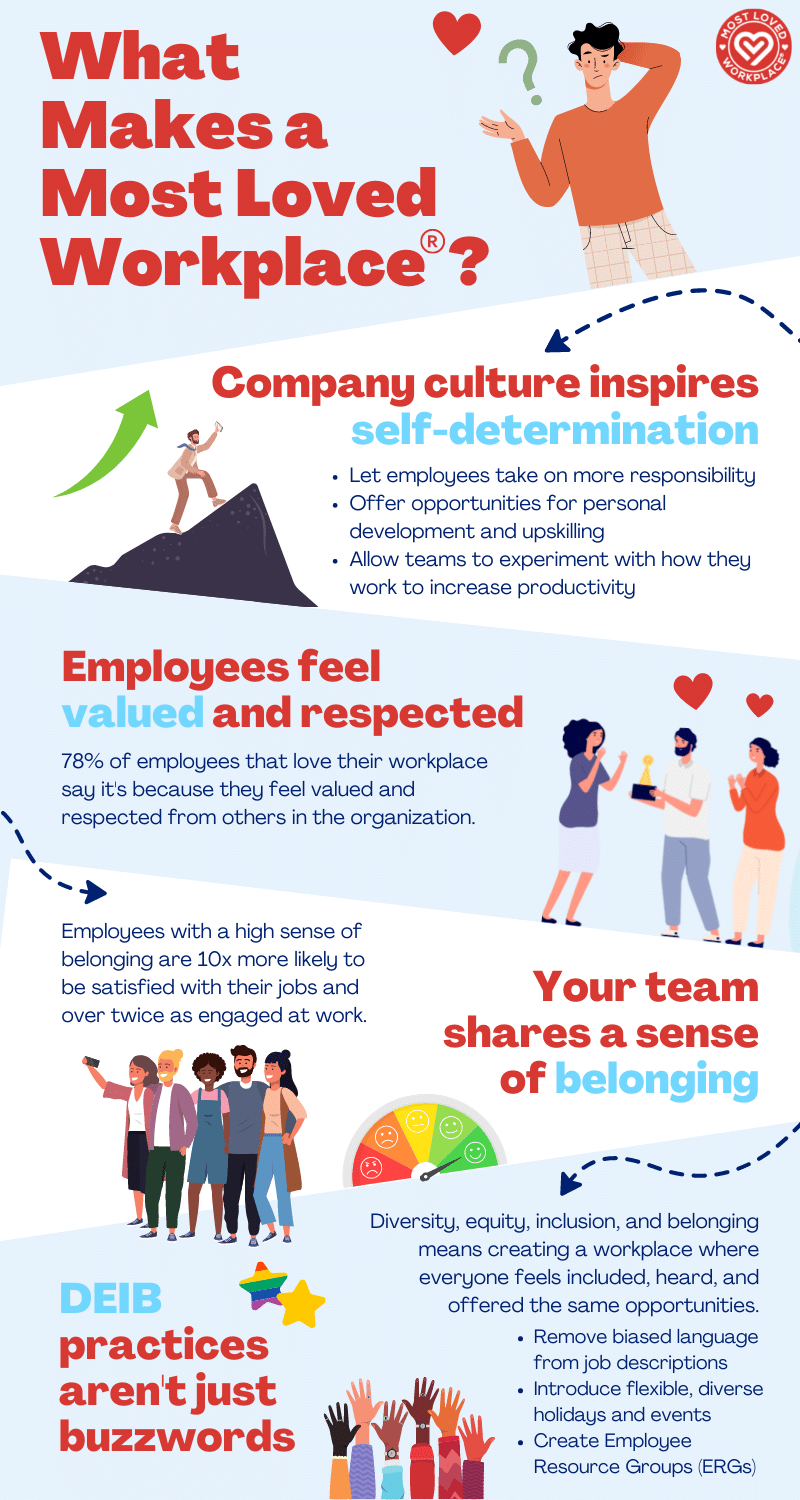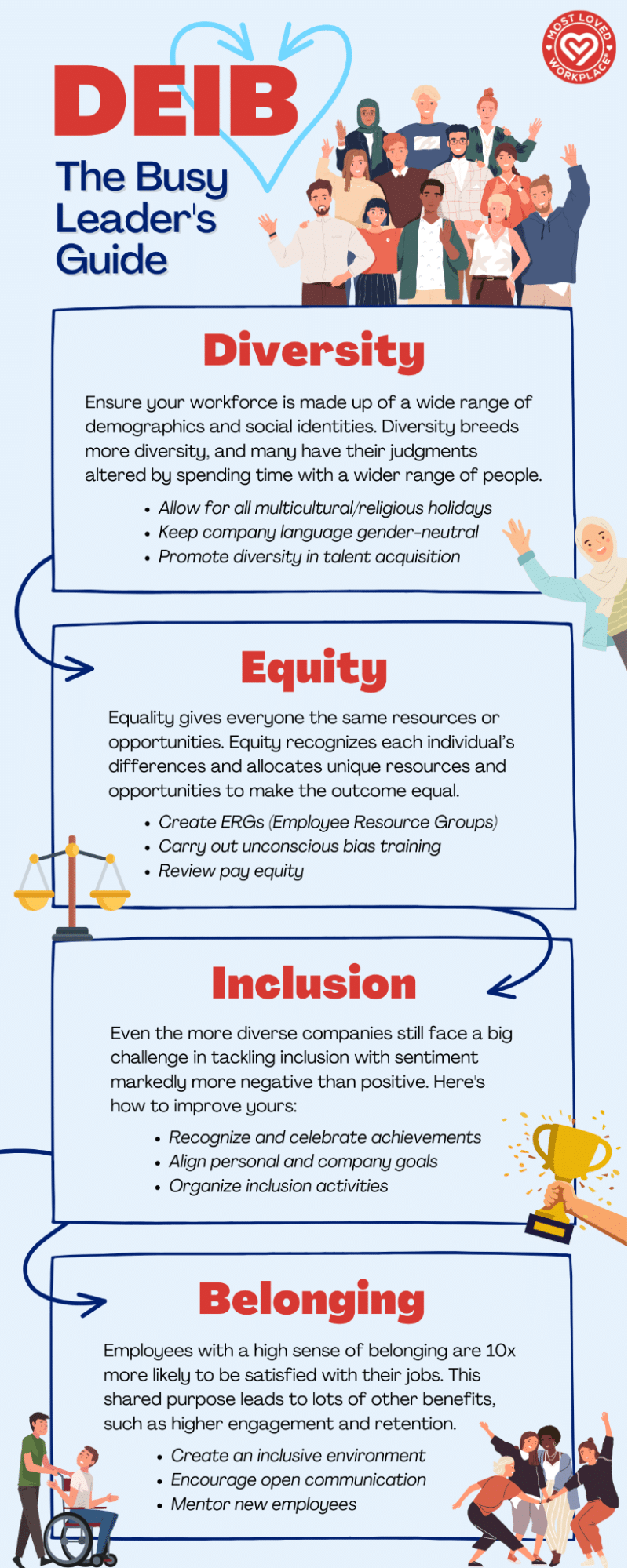What Makes a Most Loved Workplace? [Infographic]
What makes a Most Loved Workplace® ? Is it how much you’re paid? Whether or not you have a best friend in the office? The amount of free coffee or snacks available?
The best workplaces span a huge range of industries and environments. However, there are a few key factors that they all have in common—none of which depend on your company’s budget.
Any Most Loved Workplace® has a few factors in common and each of these can be implemented with time and patience:
- Your company culture inspires self-determination
- Employees feel valued and respected
- Your team shares a sense of belonging
- Your DEIB practices aren’t just buzzwords

Your Company Culture Inspires Self-Determination
When wondering how to create a great workplace, one must first understand the reasons why people work. Of course, things like financial and emotional pressure play a large part. However, there are many other factors that result in how motivated an employee is to be there.
Psychologists Edward Deci and Richard Ryan coined “Self-Determination Theory” which suggests people are motivated by:
- Competence: a need to grow from mastering skills
- Autonomy: gaining fulfillment from self-endorsed behavior
- Relatedness: a sense of belonging from connecting with people

How proactive or passive we are depends on the way we were raised and interacted with others growing up. If this is accurate, how does your workplace culture inspire these three motivators? Here are some simple ideas you may already be implementing:
-
- Let employees take on more responsibility (if they want it)
- Offer opportunities for professional development and upskilling
- Encourage leadership and team members to support each other
- Allow teams to experiment with how they work to increase productivity
Your company culture has a huge part to play in the level of everyday motivation for employees. How much of a say do they currently have in their work culture? When was the last time you asked them? Giving your team the chance to co-create it will make them feel far more invested in its success—the more ownership people have of something, the more they value it.
Try hosting workshops or sending out anonymous surveys to gather ideas from anyone who wants to be involved. Arrange for all team members that are interested to take part. Everyone has an opinion, and not having their name attached could make some more likely to share it.
Look for recurring patterns and overlaps in the subjects people bring up and obviously care about. It’ll take time and patience to collect all this feedback, but you should end up with a company culture far more well-rounded than anything you could come up with alone.
Employees Feel Valued and Respected
A great company’s success lies in the hands of its employees. Of course, your customers are important, but they’ll only be happy if you’ve got motivated employees providing a great experience for them. So, what makes an employee truly love their workplace?
Perks, incentives, and compensation fall to the bottom of the wishlist here. It may surprise you, but 78% of employees simply want to feel valued and respected by those they work with. They want to be able to share ideas and opinions without fear of being looked down on.

Do your employees already feel like they’re valued by leadership, or could this level of appreciation be improved? If you’re looking to accurately measure the current employee experience you offer, sentiment analysis can be a lot more effective than employee engagement surveys.
For example, you could ask to what degree team members agree with statements like:
-
- I love working for my boss
-
- I love working with my colleagues
-
- I love working for this company
Global studies show the main reason for 79% of people quitting their jobs is due to a lack of appreciation. So, how can you make it clear how much you value and appreciate your own employees?
-
- Ensure a healthy work-life balance
- Check in every so often to see their progress and to simply say “hello”
- Offer flexible working conditions to show you trust them
- Make sure any praise is specific and genuine
- Include everyone in the process

These practices aren’t hard to implement, but they can greatly impact the level of appreciation your employees feel. Stick to them, and you’ll find you’ve got a much happier, more motivated team.
Your Team Shares a Sense of Belonging
Employee engagement and retention come down to one major factor—a sense of belonging. Get this right, and you’ll find it much easier to hold onto your top talent for longer.
Engagement is a psychological state that constantly fluctuates depending on multiple physical and mental factors. This could be someone’s working environment, feelings toward leadership, or personal life circumstances. So, what can we do as leaders to encourage this positive feeling in the workplace?

Well, each employee has to truly understand how they fit into the company’s mission and impact the bottom line. They also need to see how much they’re appreciated for all they do. Where camaraderie and mutual respect flourish, hard work naturally follows.
Employees with a high sense of belonging are 10x more likely to be satisfied with their jobs and over twice as engaged at work. Here are a few ways you can inspire this feeling:
-
- Encourage open communication and an open-door policy from leadership
- Focus on initiatives that make people love their workplace (such as a dedication to integrity)
- Create inclusive onboarding and mentoring opportunities for new hires
- Prioritize everyone’s well-being
- Plan team-building exercises and other fun activities that let people get to know each other

As leadership or human resources, you need to help your employees’ personal goals align with the company’s. Performance reviews have their place, but try to delve into the career path your employees are hoping to follow and try to offer the resources to help them get there.
By treating each employee as an individual, they’ll all feel equally valued. An equally-valued team will find it much easier to work together as a cohesive unit. That shared sense of belonging then organically leads to decreased turnover, increased job satisfaction, and higher rates of employee retention.
Your DEIB Practices Aren’t Just Buzzwords
DEIB stands for diversity, equity, inclusion, and belonging. It means creating a workplace where everyone feels included, heard, and offered the same opportunities.
| Diversity | Hiring talent regardless of age, gender identity, ethnicity, sexual orientation, physical ability, religion, etc. |
| Equity | Giving employees different resources to balance the playing field to be offered the same opportunities. |
| Inclusion | Creating an environment where everyone feels welcomed. |
| Belonging | The sense of community and acceptance employees feel when DEI strategies are tackled. |

Implementing meaningful DEIB efforts will lead to a more engaged, effective workforce. Some of the other benefits for your workplace are:
-
- Your talent acquisition pool expands due to equal access
-
- A wider range of expertise means more creative, innovative ideas
-
- Your team feels more connected to your mission and values
-
- People feel they can bring their authentic selves into a more inclusive environment
Lots of companies like to mention DEIB in their hiring process. However, most of the time, these are just buzzwords with no real meaning behind them. A leadership team actually willing to commit to building a more diverse, inclusive workforce will see a more productive, happier one.
First, you need to understand the current employee experience and environment you provide. Does everyone feel like they have a say in important matters or is your workforce divided? There needs to be a balanced process in place to collect feedback from a wide range of people. Then you have to engage in a lot of learning to create a plan to address any comments.
There’s no point listening to people’s pain points and then doing nothing about them. So, after that, it’s time to execute each of the initiatives you’ve planned and be willing to adapt as you progress.

There are so many ways you can promote DEIB in your workplace, but here are a few to get you started:
-
- Remove biased language from job descriptions
- Introduce flexible, diverse holidays and events
- Create Employee Resource Groups (ERGs)
- Frequently assess all levels to ensure inclusion
- Set benchmarks and make meaningful changes to reach them
The success of any DEIB practices starts with leadership making them a priority and holding themselves accountable for seeing each of them through. Everyone needs to be committed to each of the processes to foster a positive workplace environment.
Final Word
Creating a Most Loved Workplace® comes down to making your people happy at all levels. This doesn’t mean bowing down to every demand, but asking how you can best make meaningful change and showing you appreciate their input regularly.
Think about your employees whenever you’re making decisions that will affect them. Create an inclusive atmosphere with a diverse range of people, and try to instill that shared sense of belonging. Ensure all processes are people-focused and you’ll find it much easier to keep everyone happy.
Are you wondering if you’re already a Most Loved Workplace? Get in touch with our team to find out.

Louis Carter is the founder and CEO of Best Practice Institute, Most Loved Workplace, and Results-Based Culture. Author of In Great Company, Change Champions Field Guide, and Best Practices in Talent Management, as well as a series of Leadership Development books. He is a trusted strategic advisor and coach to CEOs, CHROs, and leaders of mid-sized to F500 companies – enabling change and steering employer brand development together with highly effective teams, leaders, and organizations as a whole.

0 Comments